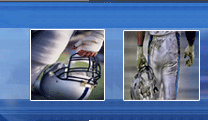| |
 New
York Jets, professional football team and one of five teams in
the Eastern Division of the American Football Conference (AFC)
of the National Football League (NFL). Formerly called the
Titans, the Jets play at Giants Stadium in East Rutherford, New
Jersey, and wear uniforms of green and white. In 1969 the Jets,
then members of the American Football League (AFL), recorded one
of the most dramatic upsets in professional football history,
stunning the Baltimore Colts in Super Bowl III. The team was led
by head coach Weeb Ewbank, wide receiver Don Maynard, and
charismatic quarterback Joe Namath. New York joined the NFL in
1970. The club fielded several powerful squads during the 1980s,
reaching the playoffs four times from 1981 to 1986. New
York Jets, professional football team and one of five teams in
the Eastern Division of the American Football Conference (AFC)
of the National Football League (NFL). Formerly called the
Titans, the Jets play at Giants Stadium in East Rutherford, New
Jersey, and wear uniforms of green and white. In 1969 the Jets,
then members of the American Football League (AFL), recorded one
of the most dramatic upsets in professional football history,
stunning the Baltimore Colts in Super Bowl III. The team was led
by head coach Weeb Ewbank, wide receiver Don Maynard, and
charismatic quarterback Joe Namath. New York joined the NFL in
1970. The club fielded several powerful squads during the 1980s,
reaching the playoffs four times from 1981 to 1986.
|
Starring on those teams were running back
Freeman McNeil, quarterback Richard Todd,
and defensive linemen Mark Gastineau and Joe
Klecko. The New York Titans became charter
members of the AFL in 1960, naming former
quarterback great Sammy Baugh as their first
head coach. The team enjoyed modest success
during its first eight seasons, finishing
second in the Eastern Division three times.
In 1963 Weeb Ewbank was named head coach,
and the team’s name was changed to the Jets
because the team’s home, Shea Stadium, is
located between New York’s John F. Kennedy
International and La Guardia Airports. The
Jets produced back-to-back rookies of the
year in 1964 and 1965—running back Matt
Snell and Joe Namath. In 1967 Namath became
the first professional quarterback to throw
for more than 4,000 yards in one season. Don
Maynard led the league in receiving yards
that season; he eventually became the AFL’s
career leader in yards and receptions. In
1968 Namath directed New York to the AFL
championship. He then brashly predicted a
victory over the heavily favored
NFL-champion Baltimore Colts in Super Bowl
III. Namath delivered on his promise as the
Jets shocked the Colts 16-7. Ewbank, who
coached the Baltimore Colts to an NFL
Championship in 1959 (before the Super Bowl
was played between the NFL and AFL), became
the only head coach to win championships in
both leagues, and Namath was named AFL most
valuable player (MVP). |
|
 |
|
New York repeated as AFL Eastern
Division champions in 1969, and the team
joined the NFL a year later when the NFL
and AFL completed their merger. Despite
rosters that featured Namath, running
back John Riggins, and wide receiver
Wesley Walker, the team managed only one
second-place finish during its first 11
seasons in the league. The Jets made
back-to-back playoff appearances in 1981
and 1982, led by Richard Todd, Freeman
McNeil, Mark Gastineau, and Joe Klecko.
In 1981 the team led the NFL in
quarterback sacks as Gastineau notched
20 and Klecko totaled 201/2. New York
reached the AFC Championship Game in the
1982 season but was defeated by the
Miami Dolphins, 14-0. Around this time
the Jets’ intimidating defensive line
became known as the New York Sack
Exchange; the nickname was derived from
the fact that New York City houses the
New York Stock Exchange. |
|
|
New
York’s performance was sporadic during the
late 1980s and early 1990s. Leading players
included McNeil, quarterback Ken O’Brien,
and wide receiver Al Toon. Quarterback
Boomer Esiason joined the Jets in 1993, but
the franchise encountered repeated
frustration, including placing last in its
division in 1996. At the end of the 1996
season, the Jets traded four draft picks to
the New England Patriots to gain the right
to hire coach Bill Parcells, who had guided
both the New York Giants and the Patriots to
Super Bowl appearances. Under Parcells’s
direction, the Jets had a remarkable
turnaround. In 1997 they finished with a 9-7
win-loss record and barely missed the
playoffs. In 1998 they posted a 12-4
win-loss record in the regular season and
captured the Eastern Division title behind
the play of quarterback Vinny Testaverde,
running back Curtis Martin, and receiver
Keyshawn Johnson. During the playoffs the
Jets defeated the Jacksonville Jaguars
before falling to the Denver Broncos in the
AFC Championship Game.
|
| |
|
|







